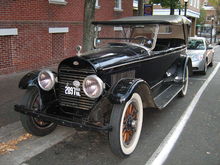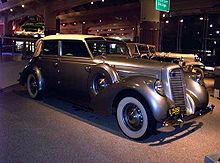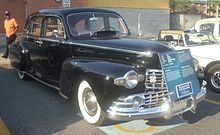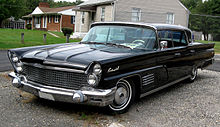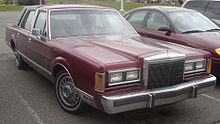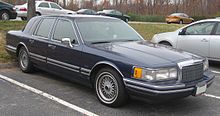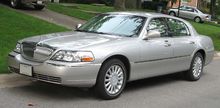
Lincoln Motor Company
Background to the schools Wikipedia
SOS Children, an education charity, organised this selection. With SOS Children you can choose to sponsor children in over a hundred countries
|
||||||||||||||||||||||
The Lincoln Motor Company (also known simply as Lincoln) is a United States-based division of the Ford Motor Company that sells luxury vehicles under the Lincoln brand, primarily in North America. The current Lincoln model range in the United States includes two sedans, the MKS and MKZ, two crossovers, the MKT, the MKX and one SUV, the Navigator. Ford is planning to expand the model range to seven different vehicles by 2015 as well as begin selling Lincoln-branded vehicles in China's rapidly expanding luxury car market by 2014.
History
Henry Leland, a former manager of the Cadillac division of General Motors, and his son, Wilfred Leland, formed the Lincoln Motor Company in August, 1917. Leland named the new company after Abraham Lincoln, his hero and for whom he cast a vote in 1864. Lincoln's first source of revenue came from assembling Liberty aircraft engines, using cylinders supplied by Ford Motor Company, to fulfill World War I government contracts.
After the war, the Lincoln factories were retooled to manufacture luxury automobiles. Ford Motor Company purchased the Lincoln Motor Company in 1922, but Lincoln continued to operate as a somewhat separate company from Ford through early 1940. On April 30, 1940 the Lincoln Motor Company became the Lincoln Division of Ford Motor Company.
Purchase by Ford
The company encountered severe financial troubles during the transition, coupled with body styling that wasn't comparable to other luxury makers, and after having produced only 150 Lincoln L-series cars in 1922, was forced into bankruptcy and sold for US$8,000,000 to the Ford Motor Company on February 4, 1922, which went to pay off some of the creditors.
The purchase of Lincoln was a personal triumph for Henry Ford, who had been forced out of his second company (after Detroit Automobile Company) by a group of investors led by Leland. Ford's company, renamed Cadillac in 1902 and purchased by rival General Motors in 1909, was Lincoln's chief competitor. Henry Ford had previously produced luxury vehicles under the Ford nameplate, called the Ford Model B in 1904, the Ford Model F in 1905, and the Ford Model K in 1906 but they weren't accepted by the automotive buying market. When Ford acquired Lincoln, it quickly became one of America's top selling luxury brands alongside Cadillac, Pierce-Arrow, Marmon, Peerless, Duesenberg, and Packard. Ford made no immediate change, either in the chassis or the V8 L-head engine which was rated 36.4 SAE and produced 90 bhp (67 kW; 91 PS) at 2,800 rpm. An unusual feature of this power unit was the 60 degree separation of the cylinder blocks that helped to cut down on synchronous vibration found with similar engines with 90 degree separation produced at the time. After the Ford takeover, bodywork changes and reduced prices increased sales to 5,512 vehicles from March to December 1922.
At the direction of Henry's son Edsel, in 1923 several body styles were introduced, that included two- and three-window, four-door sedans and a phaeton that accommodated four passengers. They also offered a two-passenger roadster and a seven-passenger touring sedan and limousine, which was sold for $5,200. A sedan, limo, cabriolet and town car were also offered by coachbuilders Fleetwood, Derham and Dietrich, and a second cabriolet was offered by coachbuilder Brunn. Lincoln contracted with dozens of coachbuilders during the 1920s and early 30s to create multiple custom built vehicles, to include American, Anderson, Babcock, Holbrook, Judkins, Lang, LeBaron, Locke, Murray, Towson, and Willoughby in the 1920s. Murphy, Rollston, and Waterhouse were added in the 1930s.
Vehicles built by these coachbuilders went for as much as $7,200, and despite the limited market appeal, Lincoln sales rose about 45 percent to produce 7,875 cars and the company was operating at a profit by the end of 1923.
In 1924 large touring sedans began to be used by police departments around the country. They were known as Police Flyers, which were equipped with four-wheel brakes, two years before they were introduced on private sale vehicles. These specially equipped vehicles, with bulletproof windshields measuring 7/8 of an inch thick and spot lights mounted on the ends of the windshield, also came with an automatic windshield wiper for the driver and a hand-operated wiper for the front passenger. Police whistles were coupled to the exhaust system and gun racks were also fitted to these vehicles.
Optional equipment was not necessarily an issue with Lincolns sold during the 1920s, however, customers who wanted special items were accommodated. A nickel-plated radiator shell could be installed for $25, varnished natural wood wheels were $15, or Rudge-Whitworth centre-lock wire wheels for another $100. Disteel steel disc wheels were also available for $60. Lincoln chose not to make yearly model changes, used as a marketing tool of the time, designed to lure new customers. Lincoln customers of the time were known to purchase more than one Lincoln with different bodywork, so changing the vehicle yearly was not done to accommodate their customer base.
Lincoln brand image
In 1927, Lincoln attached a greyhound as the hood ornament, then in the 1930s used a coat of arms with a red cross in the centre and a knight's helmet at the top as the official emblem. The introduction of a coat of arms for Lincoln coincided with the introduction of a Ford coat of arms starting in the mid-1950s. The coat of arms appeared on various Lincoln models until the mid-1950s when the coat of arms evolved into the framed, four-pointed star that is currently in use.
In 1932, Lincoln introduced the V12-powered KB platform alongside the V8 powered KA platform with an all new streamlined appearance. In 1933, Eugene T. "Bob" Gregorie, at the styling studio created by Edsel Ford, began designing the smaller Lincoln-Zephyr, which led to the first Continental, a bespoke one-off specially created for Edsel Ford, Henry's son.
Lincoln-Zephyr
The smaller Lincoln-Zephyr was introduced for the 1936 model year as a marque of its own, with a 267 cu in (4.4 L) V12. The Lincoln-Zephyr was so successful in its first year as to increase Lincoln sales nearly ninefold. It remained a separate marque until the end of the 1940 model year and then became a model under Lincoln, when the large Lincoln Twelve was discontinued. In the 1941 model year, all Lincolns were based on the Zephyr chassis, and when production resumed after the War the Zephyr name was not continued.
Continental
The Continental started as a one-off project car for Edsel Ford, who wanted a European-style car to drive around on vacations in Florida that would be unlike the boxier designs his father's company produced. Gregorie sectioned a 1939 Lincoln-Zephyr V-12 Convertible Coupe 4 inches (102 mm) and this custom-built personal car was given the styling features known from later Continental Marks including the vertically mounted spare tire. The car was put in production for the 1940 model year as a model under Lincoln-Zephyr. In June 1940 the Club Coupe was added and from 1941-48 it was a model under Lincoln marque. When production ceased in 1948 a total of 5322 had been built. The Continental's spare tire mount was very distinctive and those who work on custom cars still call adding a similar mount a " Continental kit".
The Continental Mark II revived the concept. It was now a separate marque developed by the Continental Division and production ran between June 1955 and May 1957. The Mark II had a basic list price of $10,000, the same as a Rolls-Royce in 1978 the coninental had a Rolls-Royce grill. The Continental Division was formed on October 16, 1954 and overseen by Lincoln Division on July 18, 1956. They continued producing cars under the Continental marque for 1957-59 and again from 1969-85.
The Continental name was dropped from the Mark series coupes in 1986 but still continued on as a Lincoln sedan model until being discontinued in 2002. A "Continental Edition" Town Car was also briefly offered in 2010 and 2011.
Town Car
The Continental became Lincoln's flagship model until 1981 when the Town Car, previously the Continental's top trim level, became its own model and took over that role. The Town Car was discontinued in 2011.
In 1998 Lincoln was the best-selling luxury brand in the United States, helped by the massive success of the Navigator SUV, and a redesign of the Town Car as well as the Continental sedan.
Sales
Lincoln achieved its two best sales years to date in 1989 (200,315) and 1990 (231,660) thanks largely to the continuing popularity of the redesigned Continental, introduced in December 1987, and success of the redesigned Town Car introduced in October 1989.
Lincoln would go on to beat Cadillac in sales in 1998 and again in 2000 but, like other domestic brands, Lincoln sales declined over the next several years. Ford hopes to increase the brand's sales to 162,000 vehicles by 2015 with the introduction of seven all-new or significantly redesigned models.
Transition to a global brand
Lincoln was one of the Premier Automotive Group brands from 1998 to 2002, but was pulled out due to Ford's new marketing strategy of separating its import brands from its domestic marques. In recent years the company had fallen behind Japanese, European, and American competitors for a lack of new models. The company has reacted to remedy this, however, by sharing parts and platforms with other Ford divisions worldwide in an attempt to bring more new models to market faster. The result is the introduction of several new models, starting with the 2006 Mark LT pickup (later replaced by the "Platinum" version of the Ford F-150, however, the Mark LT is still available in Mexico), Zephyr (upgraded and renamed Lincoln MKZ for the 2007 model year), and the MKX Crossover SUV. Subsequent model launches were the MKS sedan in 2009, and the MKT "Touring" crossover for the 2010 model year.
Lincoln vehicles are officially available in Bahrain, Canada, Jordan, Kuwait, Lebanon, Mexico, Oman, Qatar, Saudi Arabia, South Korea, United Arab Emirates, the United States, and its territories, American Samoa, Guam, Northern Mariana Islands, Puerto Rico, and the U.S. Virgin Islands, and Yemen. Lincoln competes with other luxury brands, mainly Cadillac of Ford's American arch rival General Motors, but also to a lesser extent with brands such as Lexus of Toyota, Infiniti of Nissan, Acura of Honda, and Audi of Volkswagen.
Expanded lineup replacing Mercury
On June 2, 2010, Ford officially announced the closure of the Mercury line by the end of the year. Derrick Kuzak, Ford's head of product development, said seven new or updated Lincoln product lines would be developed over four years to make up for Mercury's loss. One of these would be Lincoln's first compact car.
2012 Reorganization
On December 3, 2012 Ford changed the name of the Lincoln division to the Lincoln Motor Company. To help differentiate Lincoln-branded products from Ford-branded products, Ford established unique design, product development and sales teams for Lincoln. Ford appointed Jim Farley to lead the Lincoln Motor Co.
Presidential cars

Lincoln has a long history of providing official state limousines for the U.S. President. The first car specially built for presidential use was the 1939 Lincoln V12 convertible called the " Sunshine Special", used by Franklin D. Roosevelt. It remained in use until 1948. A 1950 Lincoln Cosmopolitan called the "Bubble Top" was used by Presidents Harry S. Truman, Dwight D. Eisenhower, John F. Kennedy, and once by Lyndon B. Johnson. It was retired in 1965.
Perhaps the most famous Lincoln Presidential state car was a 1961 Lincoln Continental convertible, custom built by Hess and Eisenhart of Cincinnati, and known as the SS-100-X, designed for use by John F. Kennedy. Designed to be an open-top car to give the President better visibility and a better ability to interact with citizens, it also included a " plexiglas" bubble top to be used in the event of inclement weather. The 1961 vehicle was notorious for its inadequate cooling of the rear of the passenger cabin while the bubble top was in place, particularly in sunshine. In order to prevent excessive heat and discomfort to the passengers, the top was often removed prior to parades. It was in the back of this car that Kennedy was assassinated. Due to security concerns following Kennedy's assassination, it was temporarily removed from service. While it was originally thought that Kennedy's successor, Lyndon Johnson, had ordered it destroyed, it instead was retrofitted with armor plating and a fixed, permanent sedan roof. It reentered service and was used by Johnson and his successor, Richard Nixon. It was eventually retired in 1977 and is now on display at the Henry Ford Museum in Dearborn, Michigan. The Johnson Administration also used three 1965 Lincoln Continental Executive limousines: Two limousines for the President and one for Secretary of Defense Robert McNamara, as well as a 1968 "stretch" Lincoln to be used in Washington, D.C., and Austin, Texas. This vehicle is on display at the Lyndon Baines Johnson Library and Museum.

A state car based on a 1969 Lincoln was commissioned for Richard Nixon. Constructed by Lehman-Peterson of Chicago, this vehicle also had an added sunroof so that Nixon could stand upright when appearing before parade-goers if desired. This vehicle was equipped with several features, such as retractable hand grips and running boards, options later copied by Hess and Eisenhart. This car is now located at the Nixon Library in Yorba Linda, California. It would be replaced in 1974, when Ford supplied a 1972 Continental model which was stretched to 22 feet (7 m), outfitted with armor plating and bullet-resistant glass and powered by a 460 cu in (7.5 L) V8 engine. While intended for Nixon, it was instead used by his successor, Gerald Ford, following Nixon's resignation. It was reused by Jimmy Carter and Ronald Reagan, until it was replaced by a Cadillac Brougham in 1983. Like the SS-100-X, this state vehicle has lasting notoriety due to its presence at two assassination attempts against Presidents; it was used for a quick getaway by Gerald Ford following Sara Jane Moore's assassination attempt against him in 1975, and most notably, at John Hinckley Jr.'s assassination attempt against Ronald Reagan in 1981. It was the armor plating on the car that wounded Reagan, as no shot directly hit him; the near-fatal shot that struck him had originally hit the side of the car and ricocheted off the bulletproof armor. Reagan was quickly plunged into the car, which transported him to George Washington University hospital. Today, the car is on display at the Henry Ford Museum alongside the Sunshine Special and SS-100-X.
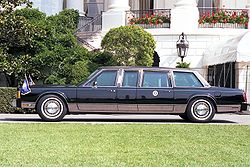
The last Lincoln to be used as a Presidential state car was a 1989 Lincoln Town Car that was commissioned for George H. W. Bush. It had a 460 cubic inch EFI V-8 out of a Ford F-250 Heavy Duty pickup truck and an E4OD four-speed automatic transmission. Upon its retirement when Bush left office in 1993, it became the last Lincoln vehicle to be used in the Presidential fleet. Subsequent Presidents Bill Clinton and George W. Bush and current President Barack Obama have used custom-built Cadillac vehicles as their state cars. Today it is on display at the George Bush Presidential Library.
Automobiles
Historic
- Lincoln L-series (1920–1930)
- Lincoln K-series (1931–1940)
- Lincoln-Zephyr (1936–1942)
- Lincoln Custom (1941–1942)
- Lincoln Continental (1941–1948, 1956–1980, 1982–2002)
- Lincoln-Zephyr Continental (1940)
- Lincoln H-series (1946–1948)
- Lincoln Sport (1949–1951)
- Lincoln Cosmopolitan (1949–1954)
- Lincoln Lido (1950–1951)
- Lincoln Capri (1952–1959)
- Lincoln Custom (1955)
- Lincoln Mark Series (1956–1998)
- Lincoln Premiere (1956–1960)
- Lincoln Versailles (1977–1980)
- Lincoln LS (2000–2006)
- Lincoln Blackwood (2002)
- Lincoln Aviator (2003–2005)
- Lincoln Zephyr (2006)
- Lincoln Town Car (1981–2011)
Current
In the 2007 model year, Lincoln introduced a new naming system with most models bearing a three-letter designation beginning with "MK" instead of a name. Today, only the Navigator and Mark LT names remain while all other models use the new nomenclature.
- Lincoln Navigator (1998–)
- Lincoln Mark LT (Mexico, 2006–)
- Lincoln MKX (2007–)
- Lincoln MKZ (2007–)
- Lincoln MKS (2009–)
- Lincoln MKT (2010–)
Concept
- Lincoln Continental 1950-X (1952)
- Lincoln Anniversary (1953)
- Lincoln Maharaja (1953)
- Lincoln XL-500 (1953)
- Lincoln Mardi Gras (1954)
- Lincoln Futura (1955)
- Lincoln Indianapolis(1955)
- Lincoln Continental Town Sedan (1965, 1969)
- Lincoln Coronation Coupe (1966)
- Lincoln Coronation II (1967)
- Lincoln Mark III Dual Cowl Phaeton (1970)
- Lincoln Continental Concept 90 (1982)
- Lincoln Continental Concept (1983)
- Lincoln Quicksilver (1985–1986)
- Lincoln Vignale (1987)
- Lincoln Machete (1988)
- Lincoln Marque X (1992)
- Lincoln L2K (1995)
- Lincoln Sentinel (1996)
- Lincoln Special LS (1999)
- Lincoln Mark 9 (2001)
- Lincoln Continental Concept (2002)
- Lincoln MK9 (2001)
- Lincoln Navicross (2003)
- Lincoln Mark X (2004)
- Lincoln MKR (2007)
- Lincoln C (2009)
- Lincoln MKC (2013)
Motorsport
Although a luxury division, Lincoln has not been absent from motorsports. Like all American brands of the fifties, Lincoln participated in the Grand National Stock Car series. They would continue into the eighties until the Winston Cup Series dwindled down into a Chevrolet-Pontiac-Ford affair in the nineties.
Lincoln has also powered Le Mans Prototypes, acting as a substitute for Ford, in the American Le Mans Series.

